|
|
Cooler temperatures replaced last week’s record-breaking heat. Most of the state experienced several days of mild, open weather for fieldwork during the week ending May 19. After a late start to the planting season, Wisconsin farmers capitalized on the favorable conditions and made double digit planting increases, led by corn (up 27 percentage points), oats (up 24 points) and soybeans (up 20 points). According to the latest USDA NASS Crop Progress & Condition report, 34% of the state’s corn, 54% of oats, and 26% of soybeans have now been planted.
In Wisconsin orchards, apple trees are in bloom or at the petal-fall stage, and insect activity is increasing. Reports from our network of volunteer cooperators indicate emergence of the first codling moths and overwintered plum curculio weevils has started in the southeastern counties.
__________________________________

Calibrochoa infected with CPMMoV | E. Voigt DATCP
 
|
|
Chili pepper mild mottle virus (CPMMoV) is a newly detected tobamovirus infecting calibrachoa plants this spring. Known for their small, colorful flowers and trailing habit, Calibrachoa are solanaceous annuals commonly grown in containers and hanging baskets. At the DATCP Plant Industry Lab, five varieties have tested positive for this new virus. Affected varieties include: ‘Aloha Kona Neon,’ ‘Candy Shop Candy Crush,’ ‘Frosty Lemon,’ ‘H. Peach’ and ‘Ombre Blue.’
Symptoms of CPMMoV can be expressed as leaf mottling, flower break, necrotic lesions and stunting. In the above photo, the diseased plants in the lower left corner appear mottled and more yellow compared to the surrounding plants. The full host range of this virus is not yet known. Other plants, especially solanaceous species such as pepper, petunia and tomato, may be susceptible to CPMMoV.
CPMMoV is easily transmitted from infected to healthy plants by contact and handling. Strict sanitation practices, including wearing disposable gloves at all times and disinfecting tools, equipment, and work surfaces (also door knobs, steering wheels, etc.) with a 10% bleach solution, are critical for managing this virus.
Licensed nursery growers or dealers who suspect plants may be infected with CPMMoV are encouraged to contact DATCP’s nursery program at (608) 224-4572 or datcpnursery@wisconsin.gov. Gardeners, florists or retail store customers are also advised to be alert for virus symptoms on calibrachoa this year and to contact the UW-Madison Plant Disease Diagnostics Clinic if CPMMoV is suspected. Local vegetable farmers should use caution when bringing calibrachoa onto their farms since CPMMoV may pose a threat to their crops. |
|
 __________________________________
|
|
|
Codling moth | Mark Doerr WSU
  Spring codling moth (CM) emergence began this week in southeastern Wisconsin orchards. Apple growers in the DATCP Apple Pest Monitoring Network are advised to begin checking their CM traps daily until the “biofix” is established. In some years, determining this event is complicated by fluctuating temperatures that lead to inconsistent emergence. The biofix is either the date of the first sustained flight of moths captured multiple days in a row or when counts exceed the threshold of five moths per trap per week. This date marks the point at which to begin counting degree days (base 50°F) to determine the optimal treatment window for first-generation larvae.
In addition to CM emergence, another key spring event now underway is the migration of plum curculio (PC) into orchard edges. The stings and egg-laying scars made by the female weevils will become detectable on developing fruitlets within the next two weeks. Cultivars with early-sizing fruits 5 mm or larger (e.g., Ida red, Liberty, Paula red, Zestar) are preferred for egg laying.
Perimeter sprays can be used as an alternative to full cover sprays if PC injury is limited to the border rows. However, if egg laying scars are found beyond the first 4-5 rows of trees, a cover spray is the better approach. Organic growers have the option of applying Surround® (kaolin clay). Another strategy is to leave untreated “trap rows” of early varieties that are treated with an insecticide such as PyGanic at night when the weevils are active.
To protect bees and other pollinators during the bloom window, waiting until 100% of petals are off of trees is recommended before applying perimeter or cover sprays. Applications made between the hours of 7:00 pm and 7:00 am will avoid peak bee activity. Spraying on overcast days when temperatures are below 50°F will also reduce risk since honey bees do not fly at temperatures (<50°F) below this threshold or during low sunlight conditions.
 __________________________________
|
|
 CPMMoV mottle on calibrachoa | E. Voigt DATCP
|
|
|
|